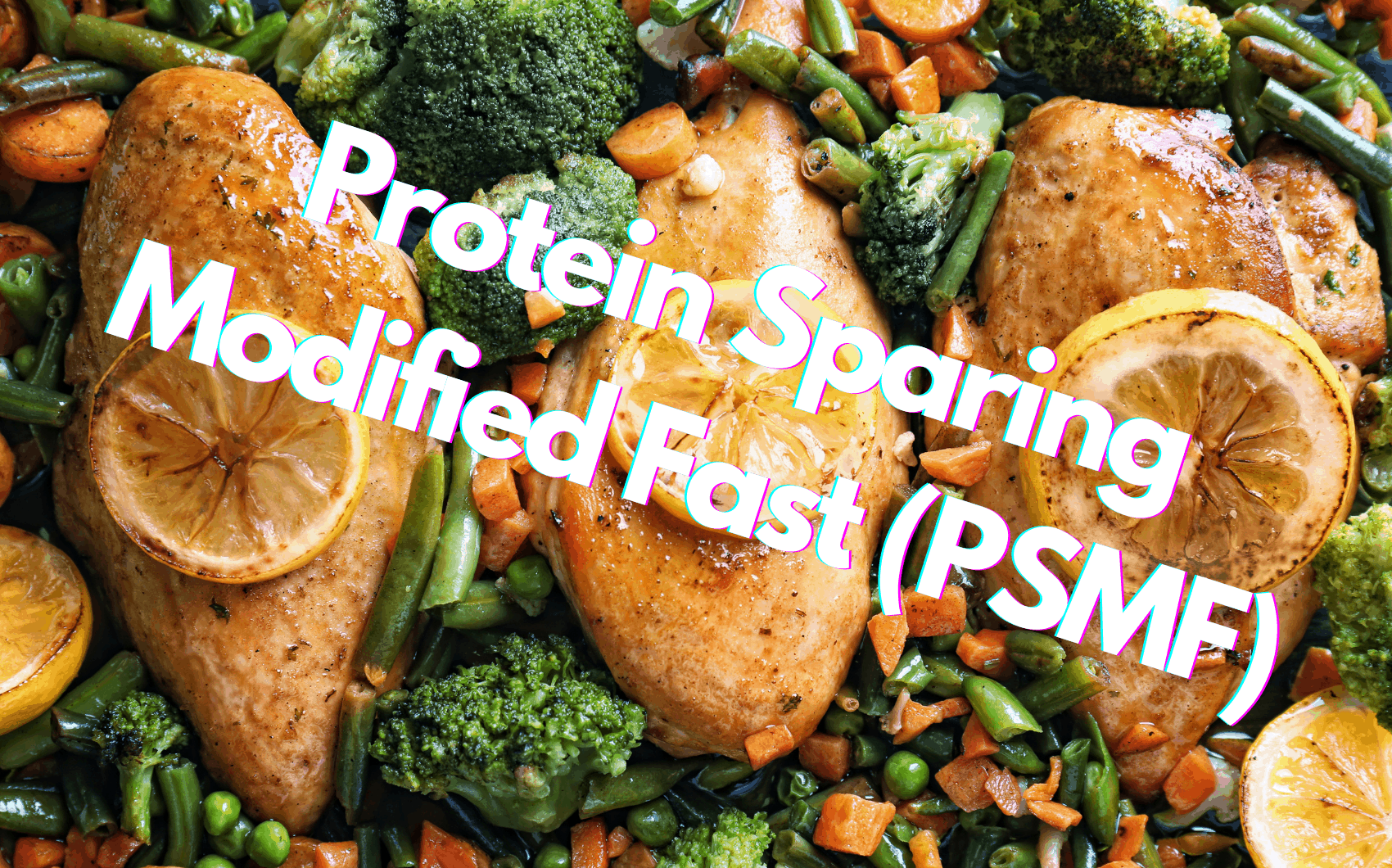Protein-Sparing Modified Fast Review: Does It Aid Weight Loss?
-Trying to find a legitimate low-calorie diet approach to help you drop pounds of fat fast always feels like an uphill battle.
No, it’s not that there is a shortage of weight loss programs out there.
If anything, the opposite is the truth – and sifting through the endless options is what makes finding a program that works (and that you can stick to) so challenging.
But that’s part of what makes Protein Sparing Modified Fasts (PSMFs) so special!
To be able to separate itself from the rest of the pack, so to speak, and become as popular as it is today is a testament to how effective its results really are.
If you’ve been on the hunt for a proven rapid weight loss diet that isn’t going to have your numbers on the scale yo-yo-ing back and forth uncontrollably, a low-calorie diet that isn’t going to crush your energy levels, a low-calorie diet that will preserve your lean body mass, not raise your blood pressure and a diet that isn’t going to eliminate all of your favorite foods, you’ve come to the right place.
Let’s dig right in!
What is the Protein Sparing Modified Fast, Anyway?
The PSMF Diet is a unique hybrid approach to rapid weight loss that combines the proven to be an effective low-calorie diet with smart fasting to preserve your lean muscle mass while kicking your fat-burning potential into high gear.
It was first introduced at the Cleveland clinic for patients with severe obesity who needed significant weight loss before surgery.
This is not a diet requiring lifestyle changes or a long-term diet to hit a certain goal weight.
Anyone that has ever jumped headfirst into a low-calorie diet knows that eating a conventional low-calorie diet at a significant caloric deficit will melt fat pretty quickly. Still, it’s going to take quite a bit of lean muscle mass with it, along with your body fat.
Sure, you’ll drop pounds and look a lot thinner in record time – but you also lose any of your hard-won gains and will end up a whole lot weaker and with less energy along the way, too.
That kind of approach isn’t going to work well for folks that want to lose a little extra around the middle while maintaining their beach body at the same time.
With the PSMF Diet, though, you’re able to restrict your caloric intake in a big way (oftentimes dropping your daily intake to anywhere between 20% and 35% or so of your daily caloric intake for maintaining your weight as is) without watching your muscles waste away at the same time.
This is done through the process of “protein sparing,” which is basically a fancy way of saying you eat almost nothing but very lean proteins and fibrous vegetables to fuel your muscles and protect them during the rapid weight loss process.
On top of that, you’re doing a modified fast that puts your body into fat-melting mode most of the day – most people go with an 18 hour fast and a six-hour feeding window – that ramps up your metabolism and really turns you into a fat-burning furnace around-the-clock.
When done correctly, it’s not hard to drop anywhere between 5 and 10 pounds of fat in a two-week block of time (and sometimes a whole lot more than that, a whole lot faster than that, too).
Let’s dig a little bit deeper into the ins and outs of this rapid weight loss program to see if it’s really for you!
A typical PSFM consists of the “Intensive Phase,” which can last up to 6 months and typically cut calories to around 800 a day, consisting primarily of protein-rich foods while cutting back on carbohydrates and fat. It introduces a “refeed” phase that slowly reintroduces calories (including carbohydrates and fats) back to a more normal level. You can check out “NORMAL” levels here using our diet macro calculator .
.
Typically these PSMF programs are done under medical supervision and are designed for severely overweight and obese patients to decrease their fat stores and lose a large amount of weight.
Won’t “Crash Dieting” Kill My Metabolism and Wreak Havoc on My Health?
Many people, including a lot of people in the fitness and nutrition world, should really know better mistakenly claim that the PSMF approach is somehow a “crash diet” that’s inevitably going to kill your metabolism and wreak havoc on your health.
We can tell you that while there is definitely the potential for this diet program to be abused and misused, and that it’s possible to throw a monkey wrench into your metabolism and do a number on your short and long-term health with any low-calorie diet when done correctly you have nothing to worry about.
You see, the PSMF diet isn’t designed to be a “crash diet” – and it definitely isn’t something you’re going to want to do one day just by flipping a switch out of the clear blue sky, either.
No, this is a systematic weight loss program that is very intelligently laid out and very strategic.
It’s something that you’re going to want to think about and consider before you jump right in, and it’s something that you’ll want to ease your body into as well.
A lot of people begin just by prepping their body with longer-term fasts.
Luckily, most of us sleep for anywhere between six and eight hours a day where we are fasting already – and bumping that up to 12 hours, 14 hours, or even 16 hours of fasting before we take our first bite of food doesn’t take all that much of an adjustment.
Do that for a couple of weeks to sort of prep your body, still eating the same foods you always eat, and you’ll be able to transition into the PSMF part of the diet where you focus almost exclusively on high-quality lean proteins and fibrous vegetables with a super low caloric daily intake.
That transition may take you another two or three weeks until you follow the PSMF program as strictly as possible, or it may take you four or five weeks to make the transition completely.
The idea here is to slowly turn the dial on your metabolism until you are shredding fat and protecting muscle. You’re not looking to shock therapy your body into starvation mode!
Take this kind of approach, and you’ll be able to enjoy incredible results in the weight loss department without putting your short or long-term health in jeopardy all the way.
Does the Protein Sparing Modified Fast Really Work?
Absolutely it does!
Experimentation with the PSMF diet approach to losing weight started in earnest back in the 1970s.
Physicians back then were looking for a more effective way to help their significantly overweight patients lose a lot of extra fat in a hurry without tanking their vital signs and putting their overall wellness at risk at the same time.
The idea to severely restrict overall calorie intake wasn’t all that new. Still, the idea of combining fasts with a mostly protein diet (with almost no carbohydrates whatsoever) was revolutionary at the time – but the results were undeniable.
People were eating more grams of protein per day than they had ever eaten in their lives but were enjoying rapid weight loss at the same time, many of them avoiding bariatric surgery that would have been necessary otherwise.
The PSMF diet method had been refined since those early experimental days nearly 50 years ago, and today it has been honed into one of the most effective fat loss programs you’re going to find under the sun.
Is This a Temporary Weight Loss Solution or More Permanent?
It would help if you understood the PSMF diet because it is not designed or engineered to be a long-term eating plan for those who want to shred fat from their body and then keep it off permanently.
No, this eating plan is designed first and foremost with rapid weight loss in mind.
If you absolutely, positively have to drop 10, 15, 20 pounds or more in a hurry – we are talking about in a couple of weeks, really – there’s maybe no other diet plan that can produce results as consistent and as quick as this one can.
A modified PSMF diet is also used by fitness models and bodybuilders when they need a quick fix to drop some body fat before a photo shoot to look amazing.
Typically they use a shortened version of up to a week sticking to the intensive phase and hitting a small refeeding phase at the end of the week.
This high-protein diet will allow the user to preserve all his/her muscles while getting enough protein to fuel workouts.
All without melting away all of those hard-won lean muscle mass gains from intense workouts along the way, too.
At the same time, though, this incredibly low-calorie diet that severely restricts your daily calorie intake is not intended to be your “new normal.”
After three or four weeks (maximum) of eating this way, you will want to transition away to something that keeps your caloric intake somewhat restricted but something that has a little more freedom when it comes to what you eat and how you fuel your body.
Many people move from a Protein Sparing Modified Fast approach to eating a keto or paleo diet.
The transition there is super easy (many of the fundamentals are the same), and neither of those two dietary approaches is as restrictive as PSMF.
Those are “eat for life” kinds of programs that you can follow long-term, enjoying significant health benefits and permanent weight loss at the same time.
Many people also like to transition from this modified fast to something like Intermittent Fasting, especially those that have a bit of a sweet tooth or those that love carbs but don’t want to sacrifice all the amazing weight loss gains PSMF has produced at the same time.
At the end of the day, this is a scalpel and not a life plan!
Outlining the Dietary Restrictions with This Diet
As highlighted above, you’re going to want to make sure that the overwhelming majority of the food you eat each day on this diet is either lean, quality sources of protein or fibrous vegetables – and nothing else.
Whether that protein source comes in the form of lean beef, chicken, turkey, fish, or something else entirely is up to you.
The idea here, though, is to make sure that the overwhelming majority of your limited calories are coming from a quality protein.
In the fibrous vegetable department, you’re going to want to stick to things like broccoli, leafy salad greens, zucchini and squash, and green beans (or something similar). Try to keep your intake of vegetables down to about 150 cal or so, though.
On the flip side of things, however, here’s what you’re going to want to steer clear of when you are on the PSMF:
- High calorie and high carbohydrate foods
- Fruits of any kind whatsoever
- Dairy products
- Nuts or seeds
- Chocolate and sweets
- Fruit juices or soda
- Grains and cereals
- Any extra oil
Keep those kinds of calorie sources off of your plate during the PSMF, and you’ll be good to go!
What to Eat
In this study, the researchers observed 669 obese patients with approx 800 calories a day using the following parameters
- 1.3 to 1.5 grams of lean protein per kilo of ideal body weight. Using high-quality protein.
- 1.5 liters of water per day
- 5 grams of sodium per day (electrolyte)
- Vitamin and mineral supplements providing RDA of micronutrients.
The foods you are allowed to eat are
- Poultry including skinless chicken, turkey, duck
- Meat including lean cuts of beef, pork
- Seafood any white fish and shrimp.
- Low-fat dairy low fat cottage cheese. Low-fat cheese. slim milk
- Tofu
- Non-starchy vegetables. greens, broccoli, cabbage, cauliflower, celery, etc
- Eggs and egg whites.
- I also like to include a protein isolate mixed with water for a protein boost.
So a 200-pound woman with a goal weight of 150 pounds would consume 102 grams (1.5 grams of protein per kilo of goal weight) of protein per day while keeping the carb intake as low as possible and just using low carb vegetables as the carb source.
You can however go all the way up to 2 grams per Kilo of target bodyweight. So the max would be 136 grams of protein per day/
A Seven Day PSMF Meal Plan to Get Started!
Since you aren’t going to be eating this super restrictive diet for longer than a couple of weeks, you’re going to want to keep things as simple as possible so that you don’t stray off the path.
You can check out our low-carb recipes t o make the recipe PSMF; eliminate the butter or ghee and use non-stick pam similar. Pick any meat-based meal and mix it with a low-carb vegetable.
o make the recipe PSMF; eliminate the butter or ghee and use non-stick pam similar. Pick any meat-based meal and mix it with a low-carb vegetable.
Day One
Eggs and Spinach for breakfast
Grilled fish and broccoli for lunch
Turkey breast and roasted sprouts for dinner
Day Two
Lovers Omelet (Use non-stick and no ghee or butter)
(Use non-stick and no ghee or butter)
Baked chicken with salad for lunch
Porkchops  and asparagus for dinner
and asparagus for dinner
Day Three
Egg white omelet with vegetables for breakfast
Baked fish and boiled cabbage for lunch
Beef lettuce wraps with mushrooms and vegetables for dinner
Day Four
A couple of spoonfuls of cottage cheese with a splash of cinnamon for breakfast
Turkey meatballs and zucchini “noodles” for lunch
Lemon roasted chicken and salad for dinner
Day Five
Hard-boiled egg or two for breakfast
Grilled chicken with a salad for lunch
Grilled steak with vegetables for dinner
Day Six
Traditional omelet with onions and mushrooms for breakfast
Steak stirfry with zucchini noodles for lunch
Turkey meatball wrap with salad for dinner
Day Seven
Tofu “omelet” with peppers and onions for breakfast
Large fresh garden salad with chicken for lunch
Grilled steak and vegetables for dinner
Protein-Sparing Modified Fast PSMF Review: Does It Aid Weight Loss?
At the end of the day, we can tell you that there aren’t many rapid weight loss diets under the sun today that can produce results the way that PSMF can – and certainly, none that can produce them as reliably, as consistently, and all while still protecting your lean muscle mass along the way!
As we have highlighted a couple of times already, this is not a “lifestyle change” kind of diet.
No, this is a weight loss approach designed to produce results as quickly as possible while putting your body in a severe caloric deficit combined with intelligent fasting.
This is something you want to do for a couple of weeks (and no longer than that) before you reset, readjust, and recalibrate with a more traditional dietary approach engineered for consistent and long-term weight loss – something like the keto or paleo diets, for example.
That being said, if you need to drop between 10 and 20 pounds (or more) without cannibalizing your hard-earned muscle gains or seeing your energy levels drop through the floor, nothing beats the Protein Sparing Modified Fast method!
Does the PSMF Diet cause Ketosis ?
?
Yes, you will go into Ketosis on the Protein Sparing Modified Fast diet.
on the Protein Sparing Modified Fast diet.
Your carbohydrate intake is so low, and with your high protein intake, you will deplete your blood glucose levels and start to use body fat as fuel.
Since your intake of dietary fats is also low (Only fats from lean protein sources are allowed), your body will use body fat to produce ketones rather than dietary fat.
How Many Calories are typically in the PSMF Diet
Typically the protein-sparing modified fast will be around 800 calories. It would be best to aim for 1.5 to 2 grams per kilo of body weight of the target weight. So 1 200 pound woman aiming for a body weight of 150 pounds should be consuming approximately 102 grams of protein per day with the remainder calories comprised of low carbohydrate vegetables and fats from the lean protein sources.
What Are The Side Effects Of The PSMF Diet
A lot of side effects are the same as a keto or paleo diet.
These include
Nausea
headaches
Keto Flu
Dehydration
Low energy
The Beginner’s Guide To A Protein-Sparing Modified Fast (PSMF)
https://www.diabetesaid.com/reviews/psmf-diet.html
Should You Use a Protein Sparing Modified Fast to Lose Weight?
Recent Posts
Smoothies provide a great way to reduce your calorie consumption and feel full. If you incorporate smoothies into your dietary regimen, you can work your way to losing weight. The Smoothie Diet...
Lose 24 Pounds in 14 Days? | The Boiled Egg Diet 2 Week Plan
The egg is a villain for many, while for others it is a complete food. But for now, controversies aside, let’s discuss the egg diet and see whether it is worth a try or not. There...



